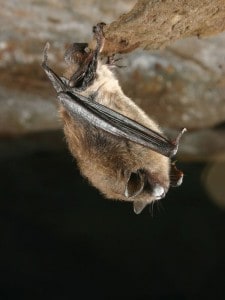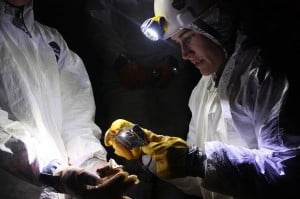In a cave, tunnel or old mine near you…nothing is stirring. Some of our most fascinating animals survive the cold of winter by hibernating. They enter a deep torpor, a kind of suspended animation. By allowing their body temperature to fall dramatically they reduce their metabolism to a level at which it is just ticking over, slowly consuming stored fat reserves as they wait for spring. Bats are among the animals that adopt this strategy. Since all Canadian bats are insectivorous it is no surprise that they have evolved to do this since there is precious little for them to eat during the winter. Some of our local bats prolong their feeding opportunities by migrating further south before hibernating and a few of our larger tree-roosting species may keep the need to hibernate to a minimum by flying as far south as Mexico. Many other bats are quietly hibernating right here in Peterborough County. Hibernating bats need cool, frost-free, stable conditions where humidity is high and they are safe from the attentions of potential predators. Caves, old mines, tunnels and other sites offering these conditions suit them best.
Like us, bats are mammals and so are warm-blooded creatures. While they are active, bats maintain a core body temperature very similar to our own, around 35oC to 37oC, but unlike us, they can allow their body temperature to fall during periods of inactivity and so conserve energy. They can do this at any time of the year, but during the winter this torpor becomes their long-term condition. Hibernating bats are largely inactive with only basic body functions operating at a level to keep them alive. They will occasionally wake up, use their fat stores to quickly raise their body temperature back to normal levels and then go in search of a drink to avoid death by dehydration. During these periods of wakefulness some male bats will also take the opportunity to mate with unaware, slumbering females. The sperm they deposit stays viable until the females become active and ovulate in the spring.
Most bats, including all Canadian species, are very small mammals. The adults of species found locally range from just 3g. to 39g.. It is surprising how long such small animals can live. Some species regularly survive in the wild for over twenty years while animals well into their thirties have been recorded in Ontario. These impressive figures have caught the attention of researchers interested in improving human longevity, since bats have the longest life spans of any mammals in relation to their size. Research shows that the bat species with the greatest life spans produce two specific proteins that may be linked to their longevity Bats are also generally very good at fending off disease so the efficiency of their immune systems is also attracting interest. Unfortunately however, their immune system is not fool proof.
Tragically, the last eight years have been a perilous time for our hibernating bats as a new disease has emerged against which they have little defense. In 2006 at a cave near Albany, New York State, bats were found to be sick and dying. Around their muzzles was a growth of a powdery fungus. The new disease became known as White Nose Syndrome. We know now that this fungus, previously unknown to science, originated in Europe and Asia. Bats on those continents can carry the fungus, but do not appear to be made sick by it: they must have evolved immunity to the fungus, possibly over thousands of years. It is assumed that spores of the fungus reached Albany on the clothes or footwear of a visitor to the cave system. Since 2006 the fungus has spread at terrifying speed and is now found in five Canadian provinces, including Ontario and twenty-five US states. It is estimated to have killed well over five million bats.
The White Nose fungus, Pseudogymnoascus destructans, gets into the skin of hibernating bats and disrupts their hibernation cycle. Infected bats wake up repeatedly, causing them to burn up their limited fat reserves and become dehydrated. Researchers with the U.S. Geological Survey and Wisconsin University recently discovered that hibernating bats with the disease use twice as much energy as healthy bats. Additionally, the infected bats show physiological imbalances that could disrupt processes such as as normal heart function. Infected bats will often leave their hibernation site in search of water and needlessly use up stored energy in a futile attempt to feed. Five of the eight species found in Ontario are thought to be vulnerable to the disease and the vast majority of infected bats die. The Little Brown Bat, formerly by far the most common bat in this part of the world, is one of the most hard-hit. The fungus is transmitted primarily from bat to bat and some experts believe it is causing the most dramatic population decline ever witnessed in mammalian populations anywhere in the world. Fortunately the fungus does not appear to pose a risk to humans, pets or livestock.
Bats consume vast quantities of insects, including mosquitoes and pests of agriculture and forestry, so the ecological and financial impact of losing so many bats to White Nose Syndrome is expected to be considerable. It is thought to have already cost agriculture many millions of dollars in extra pesticides to cope with the rise of pest populations that bats would previously have suppressed. Canadian crops most likely to be hardest hit include wheat, barley, corn, oats, canola, flaxseed, and other oilseeds. The loss of bats from natural food webs will also have unforeseen consequences as some species suffer as a result of the loss and others exploit the decline in bat numbers.
In response to the White-Nose crisis the federal government has added three species of bats to the List of Wildlife Species at Risk in Canada (also known as Schedule I of the Species at Risk Act). These three bats species – the Little Brown Bat (Myotis lucifugus), the Northern Myotis (Myotis septentrionalis) and the Tri-colored Bat (Perimyotis subflavus) are all found in this area and have been listed as Endangered.
It is believed that some North American bat species may be facing extinction because of White Nose Syndrome. Others may eventually develop immunity, but because most female bats are capable of producing only one pup per year, it may take centuries for their populations to recover. Researchers are desperately trying to find ways to protect bats. They are hoping to find natural agents that may help to rid hibernation sites of the deadly fungus.
What can ordinary people do to help bats? The most important thing is to avoid entering hibernation sites such as caves and disused mines, especially during winter. It is easy to disturb hibernating bats, causing them to unnecessarily use up their stored fat, making them even more vulnerable to disease. If we have to enter such sites we should follow the Ministry of the Natural Environment’s guidelines and take precautions to avoid disturbing bats and spreading fungal spores from one site to another. Unusual bat activity or deaths can be reported to the Canadian Cooperative Wildlife Health Centre (1-866-673-4781) or the Natural Resources Information Centre (1-800-667-1940). We should all do what we can to avoid disturbing bats at any time of year. We should protect their summer roosts in trees, barns, roofs and bridges and help maintain the natural habitats they depend on.

